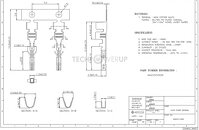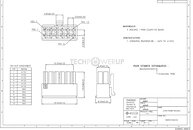- Joined
- Oct 9, 2007
- Messages
- 47,200 (7.56/day)
- Location
- Hyderabad, India
| System Name | RBMK-1000 |
|---|---|
| Processor | AMD Ryzen 7 5700G |
| Motherboard | ASUS ROG Strix B450-E Gaming |
| Cooling | DeepCool Gammax L240 V2 |
| Memory | 2x 8GB G.Skill Sniper X |
| Video Card(s) | Palit GeForce RTX 2080 SUPER GameRock |
| Storage | Western Digital Black NVMe 512GB |
| Display(s) | BenQ 1440p 60 Hz 27-inch |
| Case | Corsair Carbide 100R |
| Audio Device(s) | ASUS SupremeFX S1220A |
| Power Supply | Cooler Master MWE Gold 650W |
| Mouse | ASUS ROG Strix Impact |
| Keyboard | Gamdias Hermes E2 |
| Software | Windows 11 Pro |
Over the past few days, we've heard chatter about a new 12-pin PCIe power connector for graphics cards being introduced, particularly from Chinese language publication FCPowerUp, including a picture of the connector itself. Igor's Lab also did an in-depth technical breakdown of the connector. TechPowerUp has some new information on this from a well placed industry source. The connector is real, and will be introduced with NVIDIA's next-generation "Ampere" graphics cards. The connector appears to be NVIDIA's brain-child, and not that of any other IP- or trading group, such as the PCI-SIG, Molex or Intel. The connector was designed in response to two market realities - that high-end graphics cards inevitably need two power connectors; and it would be neater for consumers to have a single cable than having to wrestle with two; and that lower-end (<225 W) graphics cards can make do with one 8-pin or 6-pin connector.
The new NVIDIA 12-pin connector has six 12 V and six ground pins. Its designers specify higher quality contacts both on the male and female ends, which can handle higher current than the pins on 8-pin/6-pin PCIe power connectors. Depending on the PSU vendor, the 12-pin connector can even split in the middle into two 6-pin, and could be marketed as "6+6 pin." The point of contact between the two 6-pin halves are kept leveled so they align seamlessly.




As for the power delivery, we have learned that the designers will also specify the cable gauge, and with the right combination of wire gauge and pins, the connector should be capable of delivering 600 Watts of power (so it's not 2*75 W = 150 W), and not a scaling of 6-pin. Igor's Lab published an investigative report yesterday with some numbers on cable gauge that helps explain how the connector could deliver a lot more power than a combination of two common 6-pin PCIe connectors.
Looking at the keying, we can see that it will not be possible to connect two classic six-pins to it. For example pin 1 is square on the PCIe 6-pin, but on NVIDIA's 12-pin is has one corner angled. It also won't be possible to use weird combinations like 8-pin + EPS 4 pin, or similar—NVIDIA made sure people won't be able to connect their cables the wrong way.
On topic of the connector's proliferation, in addition to PSU manufacturers launching new generations of products with 12-pin connectors, most prominent manufacturers are expected to release aftermarket modular cables that can plug in to their existing PSUs. Graphics card vendors will include ketchup-and-mustard adapters that convert 2x 8-pin to 1x 12-pin; while most case/power manufacturers will release fancy aftermarket adapters with better aesthetics.
Update 08:37 UTC: I made an image in Photoshop to show the new connector layout, keying and voltage lines in a single, easy to understand graphic.
View at TechPowerUp Main Site
The new NVIDIA 12-pin connector has six 12 V and six ground pins. Its designers specify higher quality contacts both on the male and female ends, which can handle higher current than the pins on 8-pin/6-pin PCIe power connectors. Depending on the PSU vendor, the 12-pin connector can even split in the middle into two 6-pin, and could be marketed as "6+6 pin." The point of contact between the two 6-pin halves are kept leveled so they align seamlessly.




As for the power delivery, we have learned that the designers will also specify the cable gauge, and with the right combination of wire gauge and pins, the connector should be capable of delivering 600 Watts of power (so it's not 2*75 W = 150 W), and not a scaling of 6-pin. Igor's Lab published an investigative report yesterday with some numbers on cable gauge that helps explain how the connector could deliver a lot more power than a combination of two common 6-pin PCIe connectors.
Looking at the keying, we can see that it will not be possible to connect two classic six-pins to it. For example pin 1 is square on the PCIe 6-pin, but on NVIDIA's 12-pin is has one corner angled. It also won't be possible to use weird combinations like 8-pin + EPS 4 pin, or similar—NVIDIA made sure people won't be able to connect their cables the wrong way.
On topic of the connector's proliferation, in addition to PSU manufacturers launching new generations of products with 12-pin connectors, most prominent manufacturers are expected to release aftermarket modular cables that can plug in to their existing PSUs. Graphics card vendors will include ketchup-and-mustard adapters that convert 2x 8-pin to 1x 12-pin; while most case/power manufacturers will release fancy aftermarket adapters with better aesthetics.
Update 08:37 UTC: I made an image in Photoshop to show the new connector layout, keying and voltage lines in a single, easy to understand graphic.
View at TechPowerUp Main Site


 Alderpere?
Alderpere?




